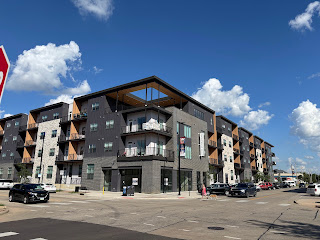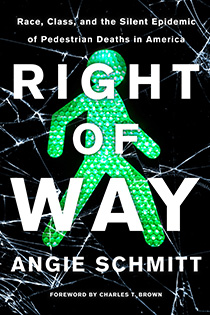Cedar Rapids Parks and Recreation's Rollin' Recmobile started its week of fun this morning at Redmond Park in the Wellington Heights neighborhood. The Recmobile van was there at 9:30, and staff had unloaded various balls, an inflatable play area...
Monday, June 28, 2021
Rollin' Recmobile brings the fun
Saturday, June 19, 2021
The crisis of authority and our common life
What does this...
 |
| Scooter on sidewalk in Iowa |
...have to do with this?
 |
| National Guard going apeshit in Oregon |
This week, Corridor Urbanism co-founder Ben Kaplan published a blog post about the local controversy over motorized scooters. It's a good piece, which explains the conflicting and complementary interests involved, while gently calling out both those who heedlessly ride-and-dump their scooters and those motorists who claim an absolute right to unobstructed driving. We can accommodate the different interests, Ben argues, and become "a city of quiet streets, with strong local businesses, where we invest in our neighborhoods, and create locally."
I think we can recognize that there have been issues with the scooters, most of which is the bad behavior of a minority of scooter users, and a lack of cultural norms surrounding how they’re supposed to be used, while also realizing that the scooters can be a huge asset to our community.... We can learn, as a community, to park them properly, ride them in the bike lanes, and signal our turns. We can build rules and a culture around scooting that make scooting less annoying. We can build more bike lanes, so scooting is safer and more practical. We can scoot boldly into a brighter future, carried by the soft hum of an electric motor.
Ben sees the main obstacle to this happy resolution being cultural resistance to change, which is hard to argue with. We live in a state where bike lanes were weird just ten years ago, where demand for COVID-19 vaccines is so low we decline the vaccine shipments, and where passenger rail is a sign of creeping Eurocommunism. But beyond that, I worry about how "we can learn, as a community," to do anything. "How can I," asked the Ethiopian eunuch in Acts 8:31, "unless someone guides me?"
Who is going to guide that boy away from scootering on the sidewalk, or tell that driver not to be aggressive in pedestrian areas (or the dog-walker to leash and pick up after their dog, or would-be DJs to turn down the music, or explosives enthusiasts to cool off the nightly fireworks, or...)?
Americans' obsession with individualism makes me skeptical that we're amenable to being guided towards norms. "If somebody had the swine flu right now, I would have them cough on me," bleated radio provocateur Glenn Beck in 2009. "I would do the exact opposite of what the homeland security says" (McNeil 2009). Republicans were then a third less likely than Democrats to say they would get the vaccine, and flu deaths by state that year rose with the percentage of Republicans (Kristof 2020, citing Baum 2011). That was eleven years before mask wearing became such a big deal.
It doesn't help that authority in America is in tatters. A new report from Pro Publica finds only ten confirmed cases of police officers being disciplined in several dozen documented incidents of excessive actions against protesters in 2020 (Simon 2021). One officer who punched a protestor six or eight times in six seconds received a written reprimand. Two fired Atlanta officers were subsequently reinstated. Weirdest of all, the National Guard, Minnesota State Patrol, and the Minneapolis Police Department all denied employing the officers who fired paint balls at someone's home.
The State of Iowa, predictably, backs the blue in a way that furthers rather than repairs the cultural rift. You don't build community by threatening people with fines and imprisonment. You build community by building public trust, and by taking accountability for your actions. For a short-term political jones, we and others across our nation have abandoned the tough but necessary work of building communities. In this environment, "the scooter problem" is not just an annoying blot on our day; it's a symptom of our collective inability even to be a community.
Tuesday, June 8, 2021
Summer Reading from Island Press
When Island Press has a sale, I'm interested, especially if they're $5 each, and even if they're e-books. Founded in 1984 as a non-profit publisher focusing on environmental issues, Island has published some fine works on urbanism, including Cities for People by Jan Gehl (2010) and The Regional City by Peter Calthorpe and William Fulton (2001). I think if I had unlimited time, space, and funds, I might buy their whole catalogue!
Reader, I did not buy their whole catalogue, but I picked a few which speak particularly well to our common lives in these times.
Shane Phillips, The Affordable City: Strategies for Putting Housing Within Reach (and Keeping it There) (Island, 2020).
Phillips addresses the shortage of affordable housing in many of America's cities by taking on what we might call Cortright's Paradox: increasing access to shelter in places with access to opportunities threatens the value of existing housing in those places. (For many households, the home they own is their major investment for retirement.)
Such a complicated problem has not yielded a slam-dunk solution, and Phillips does not pretend that it will. His approach is to seek joint gains for current homeowners, future homeowners, current and future renters, landlords, developers, and local governments. Like Matthew Desmond in Evicted [Crown, 2016], he describes a world not of clear saints and sinners, but all kinds of people mostly trying to do their best in uncertainty. A helpful introduction for non-practitioners is provided in the appendix, "Development and Real Estate Economics 101."
Phillips identifies three broad, complimentary interests: supply of places to live, stability of living situations, and subsidy by government to compensate for market failures. Under these goals he offers 40 specific policy proposals, which is a lot. They aren't a single indivisible package, though he urges governments not to adopt them piecemeal, or only to adopt the ones with particular ideological appeal. Whatever policies are pursued should be done with a joint gains strategy. For example, if housing is going to be a secure investment, it must increase in value, which makes it less and less affordable (pp. 63-64). Allowing the supply to rise to meet demand may reduce the valuation of existing homes, but it will also allow property taxes to remain manageable, and while the owner's descendants may not benefit as much from inheriting it, they will likely benefit more from being able to afford to buy their own homes when the time comes.
Angie Schmitt, Right of Way: Race, Class and the Silent Epidemic of Pedestrian Deaths in America (Island, 2020).
This was a difficult book to read, not because of the writing, which is excellent, but because of the subject matter. I can't imagine the strength of character it took to write it. Schmitt analyzes the available data and secondary sources on the thousands of pedestrian deaths each year, and comes to the inescapable conclusion that America has been willing to put up with carnage on the streets for the sake of unobstructed driving ("throughput," ch. 6) and auto industry profits (ch. 5).
Other research (chs 1-2) shows that pedestrian deaths are not random, but occur disproportionately in the new cities of the South and Southwest, on stroads where auto speeds are fast and pedestrian infrastructure is poor, and in lower-income and nonwhite neighborhoods. Pedestrian deaths are disproportionately caused by sport utility vehicles which are getting taller and heavier and consequently deadlier. (As I was reading this GMC introduced its new 9000 lb Hummer EV.) Older people and children are the most common victims. The picture this book paints of American materialism and indifference to others is bleak indeed.
She concludes on a hopeful note, that thanks to activism there has been increased awareness of the systemic nature of the problem, and that has led to design improvements in some places: better sidewalks, better street lighting, curb ramps, bus stops in safe places, longer traffic signals, more crosswalks with features to get the attention of drivers (p. 154). But even in New York City, the least car-dependent city in America, it required grieving parents to form Families for Safe Streets to get the government's attention. Making this right is going to be a long process.
Patrick M. Condon, 5 Rules for Tomorrow's Cities: Design in an Age of Urban Migration, Demographic Change, and a Disappearing Middle Class (Island, 2019).
Condon combines positivity (we can do this!) with urgency (we must do this!), in view of climate change and persistent economic and demographic trends. His five rules are:
- following Jane Jacobs, see the city not as a set of isolated problems (e.g. solve parking shortage by building more parking lots) but as an integrated and complex system;
- following Christopher Alexander ("A City is Not a Tree," Architectural Forum, 1965), see the city as a "semi-lattice" series of patterns that fail when all are run through the city center;
- make infrastructure lighter, greener, and smarter, because the principal reason we have such a maintenance backlog is that we've been profligate in building the stuff in the first place;
- use affordable housing design that accounts for the need for financing, social resilience, change over time, and accommodating an aging population; and
- adapt to new economic realities "where stagnant salaries are the norm, secure employment increasingly rare, large student loan obligations common, and elevated housing costs nearly universal" (p. 135).
Steven Higashide, Better Buses, Better Cities: How to Plan, Run, and Win the Fight for Effective Transit (Island, 2019).
- frequent, so that a bus will come within 10 minutes (ch. 2);
- fast and reliable, freed from auto traffic and obligated to make fewer stops, so that you can get to your destination in a reasonable and predictable amount of time (ch. 3);
- walkable/dignified, so you can wait in a shelter, and can get safely from your stop to your destination (ch. 4);
- fair/welcoming payment systems, with special attention to marginalized communities (ch. 5).
 |
| The D6 was our "magic bus" when we lived in DC |
10th anniversary post: CR churches
Apartments across from Greene Square, part of a surge of building in the core of Cedar Rapids Ten years ago this month, I hosted two event...

-
Look at where we are! Can you believe it?? Crowds gather for the LGBTQ Forum in Cedar Rapids The first thing to be noted about the LG...
-
Heritage Foundation, Washington DC, on a cloudy day in 2012 The first thing you notice about Project 2025, the Heritage Foundation's ma...
-
900 3rd St SE: Loftus Lofts (186 units) under construction The New Bohemia neighborhood, located on the east side of the Cedar River south o...















